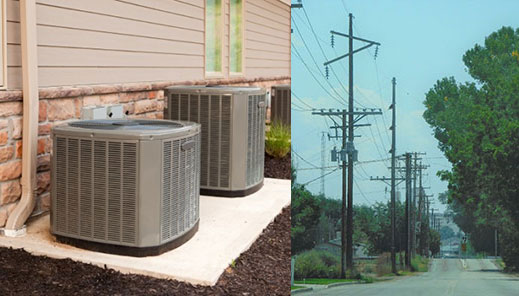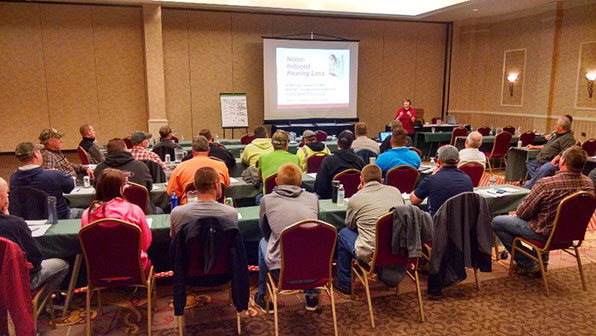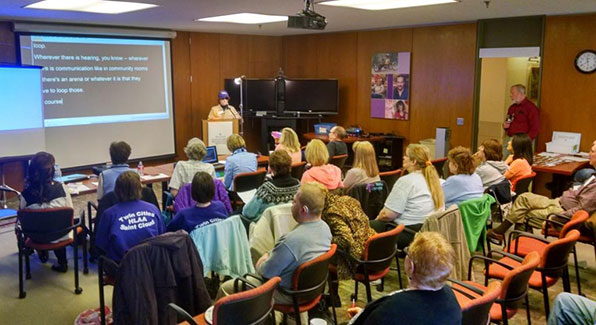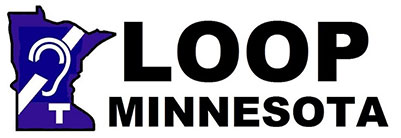On this Page
Obstacles to Hearing Loops
FM (Frequency Modulation) and IR (InfraRed) Systems
Infrared (IR) Access Systems
CART (Communication Access Realtime Translation)
Captions
More Technology
Bluetooth Technology and Hearing Loss
Obstacles to Hearing Loops
As Assistive Listening Systems, Hearing Induction Loops provide greatly improved clarity of speech signals for those with hearing loss, especially in larger venues with background noise. However, it is not always possible to install hearing loops.
Interference from other electrical equipment within the venue itself or from heavy electrical service equipment outside may lead to intolerable buzzing and general noise in the loop. Construction that involves too much metal may drain off the loop signal. Also, as the sound signal from the hearing loop tends to “leak” outside of the looped space, privacy issues can make it impossible to have a hearing loop. Anybody with a telecoil could listen in. This would be the case in medical facilities and doctors’ offices, in law offices and in court rooms, for example.

There are ways of dealing with such leakage during the loop installation but it adds an extra level of complexity to the installation. Privacy issues must be addressed with the installer ahead of time.
If there are no loops, then what?
Access with Other Assistive Technology and Devices
Lately, there has been an explosion of Assistive Listening Devices (ALDs) and assistive technology. ALDs help those with hearing loss who do NOT have access to communication with hearing aids or cochlear implants. However, ALDs can also complement hearing devices.
For many people technology details and what-goes-with-what issues are hard to figure out, especially because of fast-paced changes in the technology world.
It is therefore always best to consult with a hearing specialist or a technology expert who understands the advantages and disadvantages of ALD use in those with hearing loss. Quality and prices of products can vary greatly. Be sure that your ALD or preferred technology is compatible with your hearing instruments and that it will be helpful in the venues that you want to access.

At times like this, Public Address (PA) systems by themselves do not work well for those with hearing loss. ALDs could make a world of difference. But will people use them even if they are offered? Reluctance for many: “Visible” headsets. (Picture by Ross Hammond)
FM (Frequency Modulation) and IR (InfraRed) Systems
FM systems use Radio Waves for transmitting sound and IR Systems use Light Waves for transmitting sound.
FM Systems in Larger Venues
FM Listening systems are extremely popular. They are usually the more affordable choice. They are a mainstay for making venues like theaters, libraries, places of worship and conference and convention rooms accessible to those with hearing loss. They are also used extensively in school classrooms.
Frequency Modulation (FM) systems use radio waves to transmit sound signals wirelessly from a sound source, such as a speaker’s microphone, to the antenna in an FM receiver, which is carried by the listener. The FM receivers are the devices commonly distributed at churches, museums etc. for access to the venue.
The transmitted sound is heard through a headset that is plugged into the receiver. The listener can adjust the volume on the FM device. Less visible earbuds could also be used, but the plugs have to be compatible or match.
For people with hearing aids, the hearing aids have to be removed in order to listen to the sound. This is an obvious drawback.
However, in 2010, the Americans with Disabilities Act (ADA) made some changes to the access standards for hearing aids with Telecoils by means of neckloops. This ADA action applies to FM and IR access receivers. Click on the above link to read more.
A couple of snippets from the text regarding hearing-aid compatible receivers:
“ The 2010 Standards at section 706 require assistive listening systems to have standard mono jacks and will require hearing-aid compatible receivers to have neck loops to interface with telecoils in hearing aids.
The changes also require at least twenty-five percent (25%), but no fewer than two, of the receivers to be hearing-aid compatible. Assembly areas served by an induction loop assistive listening system will not have to provide hearing-aid compatible receivers…”
So, when FM (or IR) receivers are supplied with a neckloop, hearing aids that contain Telecoils do NOT have to be taken out. The neckloop is plugged into the FM/IR receiver for wireless communication with the hearing aid telecoils. With the hearing aids in T-MODE, no “visible” headsets are needed.
FM for personal use
Smaller, portable and compact FM devices work well for one-on-one conversations, listening to TV and conversations in small groups. Some even work well in cars where conversation is always challenging for those with hearing loss.
These are all-in-one systems: Microphone, transmitter and receiver antenna are incorporated in one device. The listener hears through a headset or earbuds that plug into the device.
Check if the device can be made compatible with hearing aids that have telecoils by plugging into a neckloop. Also, make sure that the neckloop is acceptable for use with a specific FM device.
Infrared (IR) Access Systems
IR systems are used to make public venues like places of worship, conference and convention halls accessible to those with hearing loss. The technology is approved by the ADA.
In this case, Infrared is a way of “radiating” (transmitting) sound from a speaker’s microphone to IR sensors in the IR receiver carried by the listener. Sound hitches a ride on infrared light waves. The transmitted sound is heard through a headset or earbuds that are plugged into the receiver. The listener can adjust the volume on the IR device.
IR receivers can be made compatible with hearing aids that contain Telecoils by means of a neckloop. The neckloop plugs into the IR receiver and communicates wirelessly with the Telecoils that are in T-mode. This eliminates the need of “visible” headsets.
Many people prefer the quality and increased clarity of the IR signals over FM. Infrared signals do NOT cause privacy issues the way FM or loop signals do because infrared does NOT travel through walls or even people. If privacy is an issue, IR systems are the preferred way to go.
IR for Personal Use
Infrared devices are especially popular for watching TV. They work well as long as there is no signal interruption. This would happen if someone stepped in between the listener and the TV set.
Drawbacks for FM & IR
- Many people feel stigmatized by the “visible” headsets.
- People don’t like to go and “ask” for the devices
- Venue personnel often lack training and are of little help
- Devices are poorly maintained, such as batteries are not changed
- Many cite hygiene issues, such as obviously dirty devices. Are the headset pads ever replaced? Are the earbuds disposable?
- For those with hearing loss, hearing aids must be removed in order to listen to the transmitted sound.
- Although neckloops must be available, staff might not know what they are or where they are kept.
CART (Communication Access Realtime Translation)
The easiest way to visualize CART is to think of court reporting.
In this case, the exact spoken words from speakers or videos are transcribed in real time – as they are spoken- onto a screen for people to read. The transcriptionist is usually physically present at the venue but the readout can also be remotely streamed from an off-site location to an internet browser.
If CART is provided, try to sit closer to the screen for a better view.

Audience at HLAA TC meeting. Listening through the hearing loop. CART screen is visible upfront.
CART is helpful for ALL attendees, no matter what their degree of hearing loss might be. Those with good hearing also often comment how much easier CART can make presentations, especially in larger spaces.
There are companies that provide this service and it is always a good idea to plan ahead because the transcription specialists are in high demand.
Captions
This is another way of transcribing the spoken information of TV broadcasts or movies onto the screen that is being watched. Captioning, as well as CART, depend on people not all talking at once.
Captions are also popular for telephone technology for those with hearing loss. Usually, an intermediary transcriptionist is involved but lately Voice Recognition Technology has also greatly improved. Voice recognition apps are also available for smartphones captions.
